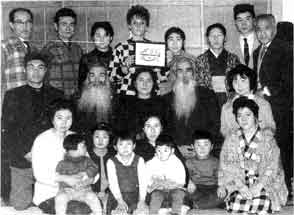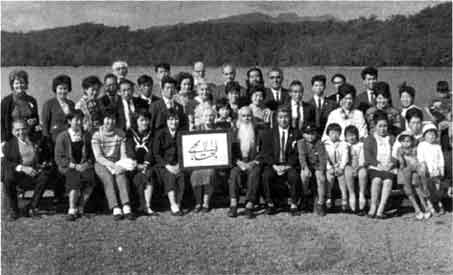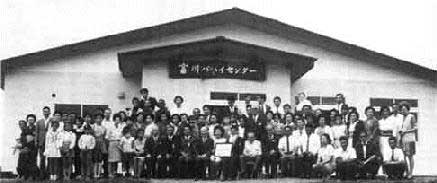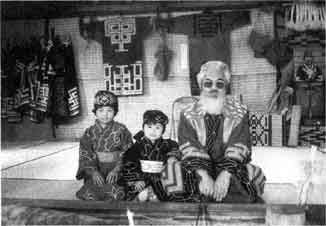
|
Traces That Remain:
A Pictorial History of the Early Days of the Bahá'í Faith among the Japanese
by Barbara R. Sims
edited by Sheridan Sims  |
chapter 66 | start page | single page | chapter 68 |  |
Chapter 67
In December 1956 the Guardian wrote of some of the tasks the National Spiritual Assembly of North East Asia, soon to be formed, should undertake. One was to extend the teaching work to Hokkaido and if possible have someone settle there.
Several months later in his message to the first National Convention of North East Asia, April 1957, the beloved Guardian gave several specific goals to the new national spiritual assembly. Among them was to spread the Faith throughout the other islands of Japan.
It was in relation to this goal that Mr. Gekie Nakajima of Osaka and Mr. Rouhollah Mumtazi undertook an eleven-day teaching trip to the large northern island of Hokkaido. There were no Bahá'ís there, and none had gone since the memorable visit of Miss Alexander, who, in 1932, was invited to Hokkaido

click here for larger image
Mr. Gekie Nakajima (standing at the left) and Mr. Rouhollah Mumtazi with Ainu friends during their trip to Hokkaido, June 1957.
On June 8, 1957, Mr. Nakajima and Mr. Mumtazi left Osaka and made the two-day trip to Hokkaido by train and ferry. There they visited several cities: Sapporo, Hakodate, Otaru and the Ainu village of Shiraoi.
They contacted the various city offices to get names of people they might visit. They were written up in newspapers and appeared on a television program that was broadcast throughout Hokkaido. This was the first mention of the Faith on television in Japan.
Mr. Yoshiro Sasaki of Sapporo later recalled that he met Mr. Nakajima and Mr. Mumtazi on a train. He, with a friend, Mr. Kinkichi Shimatani, visited them in their hotel room in Sapporo almost every night they were there. Mr. Sasaki read "Bahá'u'lláh and the New Era" in four days, and then said he wanted to become a Bahá'í. A month later his friend accepted the Faith. They were the first to become Bahá'ís in Hokkaido.
During their trip, Mr. Nakajima and Mr. Mumtazi decided to visit members of the Ainu tribe — the aborigines of Japan. They were directed by the Shiraoi city office to the house of an educated gentleman, Mr. Moritake. He was respected as a head man in the village. He was also a poet of Ainu lore. He later said that many tourists had come to the village to see the Ainu, but that this was the first time a foreigner had come and brought them something new, the Bahá'í Teachings, with pamphlets and books.
The two travellers talked to several Ainu families; usually Mr. Mumtazi talking with Mr. Nakajima translating into Japanese.
One person who listened intently was Mr. Kazutomo Umegae, the son of Mr. Moritake. Mr. Umegae had taken his wife's name when he married, which was not unusual in Japan.
When the Guardian heard about the teaching among the Ainu, a letter written on his behalf to the national assembly said, "He (the Guardian) was greatly pleased to learn of the contacts which have been made by the friends with the original natives of Japan, namely the Ainu people. He hopes that some of them will be quickened in the Faith so that they may teach the call of God to the remainder of their people. There is no doubt that great results will be achieved if this can be done.
Mr. Umegae said that one reason he and others were attracted to the Faith was because of the lack of prejudice among the
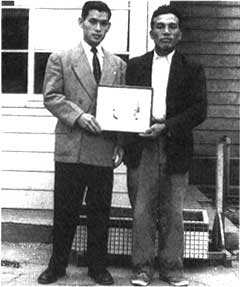
Mr. Yoshiro Sasaki and Mr. Kinkichi Shimatani, the first in Hokkaido to declare their belief in Bahá'u'lláh, 1957.

It took years of visits by various Bahá'ís before there were results. With encouragement from the Bahá'í teacher Mr. M. Labib, in December 1961 six Japanese of Ainu ancestry became Bahá'ís: Mr. Takeichi Moritake and his wife Sami, Mr. Heikichi Sumiyoshi and his wife Toki, Mr. Kazutomo Umegae and his wife Taeko. They were among the leaders of the community. One month later five more people became Bahá'ís, including one youth. The Faith was now firmly established among these interesting and loving people.
Mr. Umegae did as the Guardian predicted. He arose to teach his own people with the result that there are several villages of predominately Ainu population with large Bahá'í groups.
In talking of the early days, Mr. Umegae said that with the development of mass communication during the 1960s and 1970s, the intense prejudice that he once knew had all but died out. The colorful and interesting history and life style of the Ainu has been widely written up and shown on television. Reconstructed Ainu village houses, and demonstrations of Ainu dancing have become a tourist attraction.
Mr. Umegae was appointed as a member of the Auxiliary Board in January 1965 by the Hands of the Cause in Asia, and he functioned in that capacity for twenty-one years, longer that any other Auxiliary Board member in Japan.
To go back to 1957, in November of that year Mr. G.V. Tehrani settled in Sapporo. His going there was a direct result of the Guardian's instruction to take the Faith to Hokkaido.
Mr. Tehrani, a widower, was elderly and not in the best of health, but his great loving spirit affected those around him and with the help of the new Bahá'ís, Mr. Sasaki and Mr. Shimatani, he soon had a group interested in the Faith.
Mr. and Mrs. Assassi, pioneers to Hiroshima, purchased a house in Sapporo which they donated to the Faith. Mr. Tehrani

Hand of the Cause Miss Alexander with three of the first Ainu Bahá'ís, Mr. Umegae, his father Mr. Moritake and Mr. Sumiyoshi, December 1961.
January 1962 in Shiraoi. The middle row from the left, Mr. Umegae, Mr. Sumiyoshi, Mrs. Moritake, and Mr. Moritake who had become Bahá'ís just the month before. Miss Sandra Sims, standing holding the framed "Greatest Name" was a youth travel-teacher who stayed with the Moritake family for a few days. Mr. Muhammad Labib, standing at the right, was visiting Hokkaido. Mr. Kuriyama standing at the far left was the first Bahá'í of Shiraoi.
click here for larger image
In 1959, about a year and a half after Mr. Tehrani moved there, the first Local Spiritual Assembly of Sapporo was elected.
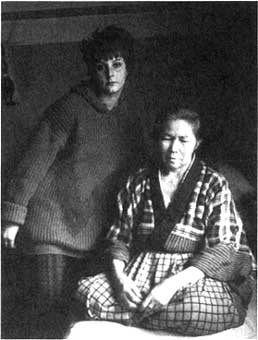
The First Youth to Travel-Teach for an Extended Period in Japan.Miss Sandra Sims (Fotos), as a child, pioneered to Japan with her parents who came during the first year of the Ten Year Crusade. As a teenager, she gave up one semester of her college education to spend three months travel-teaching in Hokkaido, 1962.
She was young, alone, and it was during the snowy winter so she attracted much attention. In those early days foreigners were rather rare, especially in the remote areas. She was written up in two newspapers and made an appearance on television. She went to thirteen cities and towns, and obtained introductions to visit city officials, schools, museums and libraries. She helped with the community in Sapporo and stayed with the new Bahá'ís in Shiraoi.
Miss Sims is shown here with Mrs. Haru Fujiyama, an Ainu woman who was originally from Sakhalin Island. The woman was in a hospital in Tokoro and had heard of Miss Sims and wanted to learn about her religion.
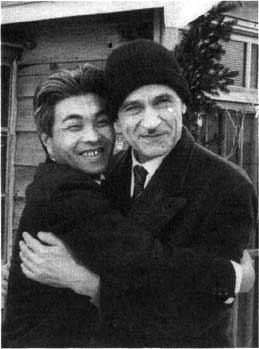
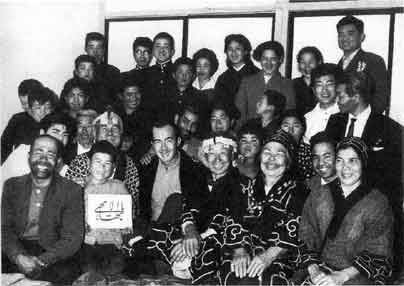
click here for larger image
Pioneer Jack Davis, sitting in front, during a meeting in the Ainu village of Nibutani, 1963. Mr. Umegae (in profile) is at the right. One of the women in front has the traditional tattoo around her mouth. Done when she was young it indicated that she was of marriagable age.

click here for larger image
Travel-Teaching in Hokkaido in 1963
Dr. Yasuyuki Hosoda, of Tokyo, (second from the right), with Mr. Umegae, (left), are teaching a family in Hokkaido. The man is looking at Dr. Hosoda's teaching album. Years later Dr. Hosoda was to become one of Japan's most eminent heart surgeons.
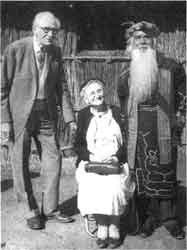
click here for larger image
Three extraordinary Bahá'ís. Mr. Leach, Miss Alexander and Chief Moritake.
190

Mr. Hideya Suzuki (left) watches as his brother Dr. Toshio Suzuki translates from English to Japanese for Hand of the Cause Miss Alexander. Dr. Suzuki went from his home in Nagasaki to help with this first conference in Hokkaido.

click here for larger image
Miss Alexander is sitting in the middle with Mr. Moritake and Mr. Umegae to the right of her. Mr. Leach is standing in the back row to the left. A total of about seventy people attended.
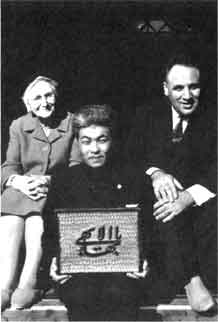
click here for larger image
Mr. Umegae is shown here with Hands of the Cause Miss Alexander and Dr. Muhajir shortly after his appointment to the Auxiliary Board in 1965. This photograph was taken at the Tokyo Bahá'í Center during a national assembly meeting the three attended. Mr. Umegae had worked very hard a few days before coming to Tokyo to finish carving the "Greatest Name" which he presented to the national spiritual assembly.Mr. Umegae's appointment fulfilled the Guardian's words about the Ainu arising to teach their own people. In the years following he travelled extensively throughout Japan, including Ogasawara Islands, teaching the Faith.

click here for larger image
A Wedding in Shiraoi
This was the wedding of Mr. and Mrs. Koichi Ishida in Shiraoi, Hokkaido,
1967.
This photograph was taken at the dedication of the Tomikawa Haziratu'l-Quds, 1969, in the town of Tomikawa which is along the remote southern coast of Hokkaido. About one hundred Bahá'ís attended the dedication, many coming from the main island of Honshu. It was the eighth Haziratu'l-Quds in Japan. Counsellor Mumtazi is sitting in the middle, to the left of the woman holding the frame containing the "Greatest Name."
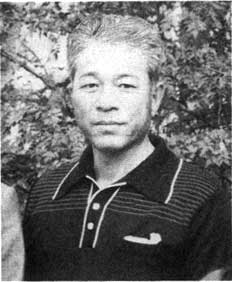
In 1974 the National Spiritual Assembly of Japan emerged from the National Spiritual Assembly of North East Asia. When the new national assembly was voted into existence, was it not fitting that a Japanese of Ainu ancestry be elected to it? Mr. Matsuo Chiba of Tomikawa, Hokkaido, served faithfully on that assembly for eight years until he was obliged to curtail his activities due to reasons of health.
This picture, taken in 1983 in Shiraoi, shows Mr. Umegae, now sixty, with granddaughters Emi, 7, and Maya, 3, during a demonstration of Ainu culture.
click here for larger image
 |
chapter 66 | start page | single page | chapter 68 |  |
|
|
